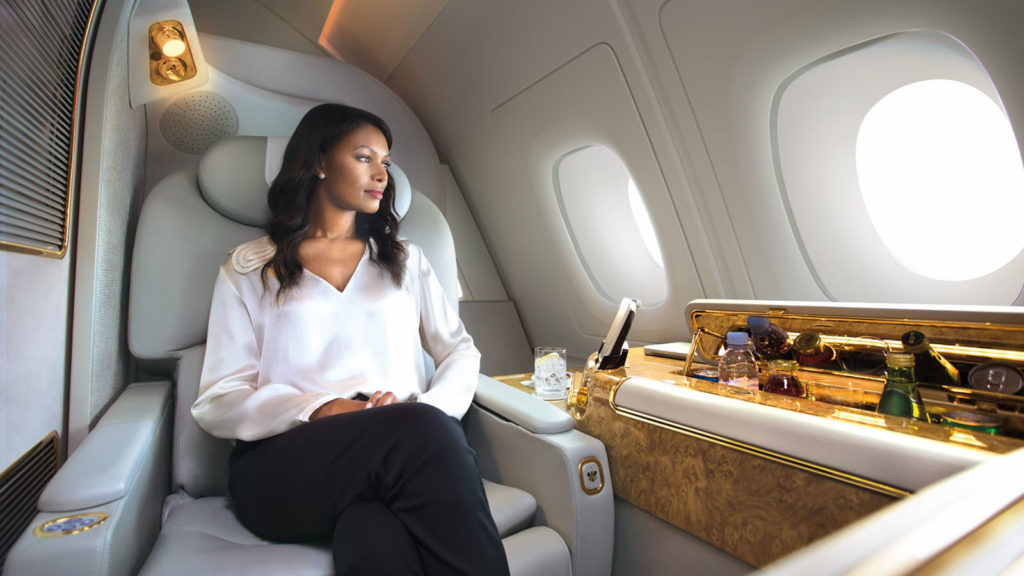Being a Qantas partner airline, Emirates allows travellers to earn Qantas Points when travelling to its Dubai hub and beyond. Yet the airline also runs its own loyalty program – Skywards. While you can’t double dip, you can choose whether to earn Qantas Points or Skywards miles every time you fly.
But which program should you choose? We take a closer look at how Qantas Frequent Flyer and Emirates Skywards compare on journeys taken with the Gulf carrier. We also see which program gets you to your next reward flight faster – whether you normally travel up front or down the back.
Where Qantas Frequent Flyer outperforms Emirates Skywards
There are many incentives for Australian travellers to stick with Qantas Frequent Flyer even if they’re regularly flying with Emirates. Here are some of those reasons.
- Overall, Qantas Points are far easier to earn in Australia than Emirates Skywards miles. This is particularly true in the credit card space. Qantas loyalists have a multitude of options for earning points on plastic, versus Skywards. Skywards now only has credit card transfer partnerships with Amex Membership Rewards and CommBank Awards.
- If you fly enough to earn status, a shiny Qantas card unlocks benefits far more widely than Skywards status. That’s primarily because Qantas belongs to the global oneworld Alliance. But it also has bespoke partnerships with other carriers like Air France, KLM, LATAM and others, through which benefits can be enjoyed.
- Qantas offers family transfers of points, with no cost or ‘points penalty’. This can make it possible for a household to move their points into a single account. From there, more significant bookings – requiring more points per person – become easier, logistically.
- If you’re flying Emirates a lot from Australia, your regular destinations are probably across the Middle East and Europe. If you can’t find a reward flight on Emirates, one of Qantas’ other many partners could take you there instead.
- Qantas generally requires fewer points to book Australian domestic flights, versus the redemption rates in Emirates Skywards miles. That’s handy when you just need to take a short trip, and may be wanting to spend the points (or miles) you’ve earned when flying with Emirates.
Of course, whether these benefits are more useful compared to Emirates Skywards will depend on the habits of each individual traveller.
Where Emirates Skywards beats Qantas Frequent Flyer
Being Emirates’ own frequent flyer program, Skywards has many natural advantages compared to Qantas Frequent Flyer. There are many differences, but here are the most impactful:
- Skywards members can earn and retain status by flying on Emirates’ native EK-coded flights. That’s not possible via Qantas Frequent Flyer, where only QF codeshares accrue Status Credits on Emirates.
- Skywards members can use miles to upgrade on Emirates flights – even after boarding the aircraft (a great way to escape an undesired neighbour!). On the other hand, Qantas Points can’t be used for upgrades with Emirates at all.
- When travelling with an Emirates Skywards number attached to the boarding pass, free or discounted inflight Wi-Fi may be available. To compare, Qantas Frequent Flyer members don’t qualify for this based on status. Any reduction in price only comes by way of cabin class.
- Silver status with Skywards grants lounge access in Dubai, whereas you’d need to be Gold or above with Qantas for the same. Speaking of lounges, Skywards Gold and Platinum members also enjoy global lounge access with Emirates. Those with Qantas status won’t find an Emirates lounge available to them in places like North America, being outside the scope of the partnership.
Skywards also brings some other subtle but interesting touches to the Emirates travel experience. For instance, the airline’s most frequent flyers can note their favourite drink in their Skywards profile. Then on every flight, it’ll be automatically served after take-off – without having to ask.
That’s far from a reason to choose one frequent flyer program over the other. But for those already enmeshed with Skywards, small VIP touches like this could be enough of a drawcard to keep those high flyers from exploring their other options.
The numbers: Qantas Frequent Flyer vs Emirates for earn and burn
Some jetsetters will have already found a compelling reason to choose either Qantas Frequent Flyer or Skywards for their regular Emirates travels. But let’s put those distinctions aside for a moment, and see how the two compare on the numbers.
For this example, we’ll start with exploring how many Qantas Points or Skywards miles would be earned on a return journey between Sydney and London via Dubai. With so many different fare categories within each cabin, we’ll highlight just the lowest and highest priced.
| Sydney-Dubai-London (return) | Qantas Frequent Flyer (QF code) | Qantas Frequent Flyer (EK code) | Skywards (QF code) | Skywards (EK code) |
| Discount Economy (Qantas) Economy Special (Emirates) | 12,400 Qantas Points | 5,300 Qantas Points | ‘Up to‘ 21,802 miles (but often less) | 2,480 miles |
| Flexible Economy (Qantas) Economy Flex Plus (Emirates) | 24,800 Qantas Points | 21,200 Qantas Points | ‘Up to’ 21,802 miles (but often less) | 24,800 miles |
| Discount Premium Economy (Qantas) Premium Economy Special (Emirates) | 24,800 Qantas Points | 23,320 Qantas Points | 23,982 miles | Not currently sold |
| Flexible Premium Economy (Qantas) Premium Economy Flex Plus (Emirates) | 34,000 Qantas Points | 23,320 Qantas Points | 23,982 miles | 27,280 miles |
| Discount Business (Qantas) Business Special (Emirates) | 37,200 Qantas Points | 26,500 Qantas Points | 27,252 miles | 27,280 miles |
| Flexible Business (Qantas) Business Flex Plus (Emirates) | 43,400 Qantas Points | 26,500 Qantas Points | 27,252 miles | 47,120 miles |
| First (Qantas) First Flex and Flex Plus (Emirates) | 49,600 Qantas Points | 31,800 Qantas Points | 32,703 miles | 62,000 miles |
As you can see from the table above, you’ll generally earn the most points when travelling on the flight number that matches the frequent flyer program. For instance, if you’re flying on Emirates’ own EK flight numbers, you’d typically earn more Skywards miles than Qantas Points on that flight. Similarly, on a QF code, you’d usually get more Qantas Points than Skywards miles.
Again, these earning rates don’t take into account any status bonuses that could be earned when travelling as a Silver member or above. Naturally, if you already have status in one program, it likely makes the most sense to stick with that program.
Using Qantas Points and Skywards miles to book Emirates flights
It’s one thing to see how many points or miles can be earned in the air. But how far can those points take you? More specifically, how many paid flights would you need to take, to earn enough points for a future trip?
To illustrate, we’ll compare the earning figures in each program against the cost in points of a Business Class reward flight. Given the Emirates focus here, we’re looking at the redemption figures only for Emirates-operated flights.
With Qantas, Emirates reward flights are bookable at fixed rates. Via Skywards though, there’s no longer a fixed reward rate. We’ve instead drawn on the best value return pricing found across a variety of dates. Here are those figures, to get us started.
- Economy Class: 132,400 Qantas Points or 167,200 Skywards miles.
- Premium Economy Class: Not currently available as a reward flight.
- Business Class: 318,000 Qantas Points or 330,500 Skywards miles.
- First Class: 455,000 Qantas Points or 405,000 Skywards miles.
At these figures, here’s how many return journeys it’d take between Sydney and London before a traveller has at least enough points or miles to book the same journey again in the cabin flown.
| Sydney-Dubai-London (return) | Qantas Frequent Flyer (QF code) | Qantas Frequent Flyer (EK code) | Skywards (QF code) | Skywards (EK code) |
| Discount Economy (Qantas) Economy Special (Emirates) | 11 returns | 25 returns | Difficult to determine given varied earn rates | 68 returns |
| Flexible Economy (Qantas) Economy Flex Plus (Emirates) | Six returns | Seven returns | Difficult to determine given varied earn rates | Seven returns |
| Discount Business (Qantas) Business Special (Emirates) | Nine returns | 12 returns | 13 returns | 13 returns |
| Flexible Business (Qantas) Business Flex Plus (Emirates) | Eight returns | 12 returns | 13 returns | Eight returns |
| First (Qantas) First Flex and Flex Plus (Emirates) | 10 returns | 15 returns | 13 returns | Seven returns |
So then, which is best?
Whether Qantas Frequent Flyer or Emirates Skywards best fits your Emirates flights will really depend on how you travel. Those booking the lowest-priced Economy fares will typically find Qantas Frequent Flyer the most rewarding, as above. Having enough points for a trip to London after 11 similar journeys sure beats having to take up to 68 journeys via Skywards.
At the front of the plane, Qantas also comes out ahead for those who can book a QF flight number. But in First Class, travelling on an EK code and crediting those flights to Skywards yields better results.
Again, there’s a lot more to consider, particularly for those who travel regularly. The benefits of status will be a big deciding factor too. Status with Emirates provides greater benefits when taking Emirates flights. But status with Qantas is recognised by a much wider range of airlines – suitable for those who fly far and wide.
It’s also worth pointing out that frequent flyer programs can change from time to time. And of course, so do people’s travel habits. Never be complacent – keep an eye on what you’re earning, and how many points you need to book a flight, to make sure you still get the best value as the years go by.
To that end, yes, Emirates does have high carrier charges on most of its reward flights. But these apply when booking journeys through both Qantas and Skywards, and are comparable. That makes the number of points earned and redeemed even more relevant, when comparing the same journey.
Images courtesy of Emirates.




Another way to think of this is the dollar-redeemable value of skywards vs QFF points (eg, per $100 of a redeemable giftcard).
I’m qantas Gold, but have two upcoming Aus-Europe business class flights coming up with Emirates. It looks like the ‘dollar redeemable’ value will be about 2x if I join skywards just for these two flights and them redeem the points for gift cards.
The QF earn rates on a EK flight number are quite meagre, and any benefit of flying EK as a gold QFF are largely irrelevant when taking a Business Class seat.
I’m inclined to join Skywards just for these two flights and then withdrawing the points.
Any thoughts?
This breakdown is great, but I’m still a bit confused, sorry!
Have just booked EK Business Class return to Europe, via Emirates reservations, on EK flight numbers. Was encouraged to join Skywards at the same time.
I had thought both QF and EK FF numbers could be added to the booking, but apparently not.
As we’re more likely to use any points accumulated on future QF domestic flights, am I better off deleting the Skywards number and adding the QF FF number, please?
Grateful for any advice.
Thank you